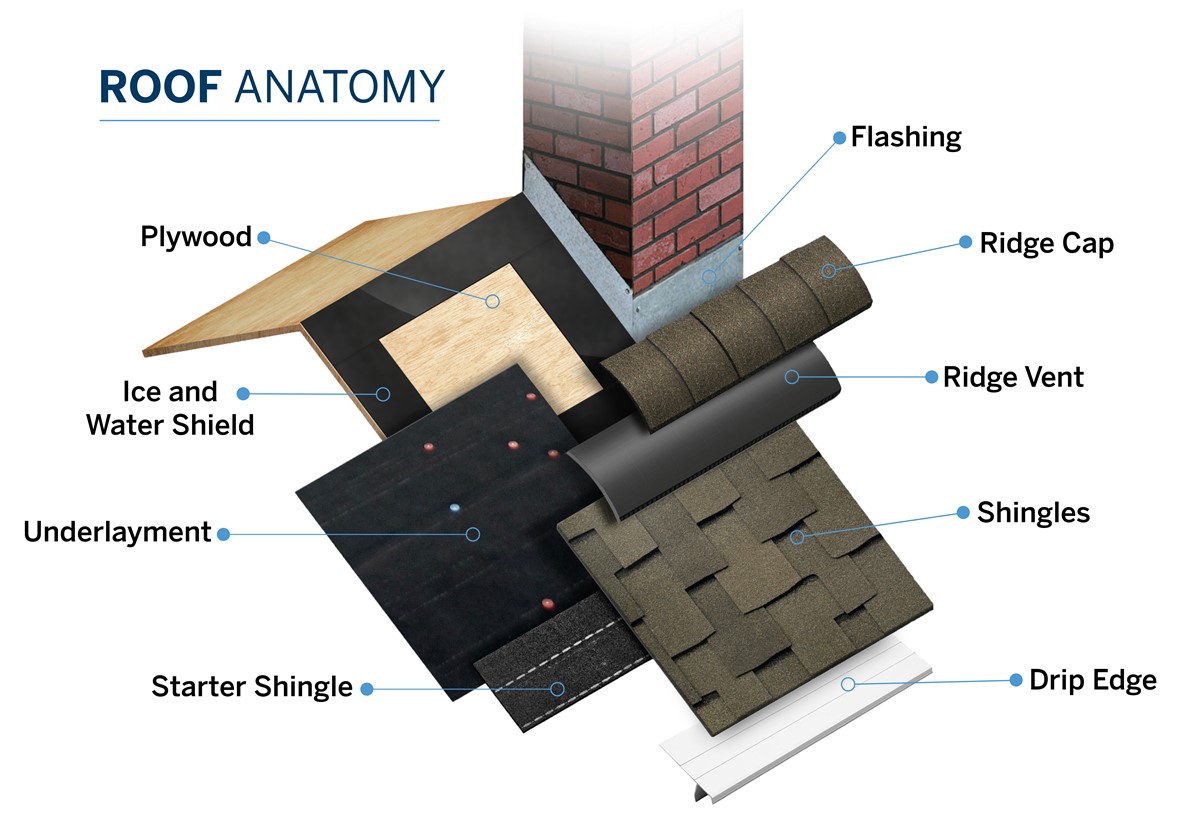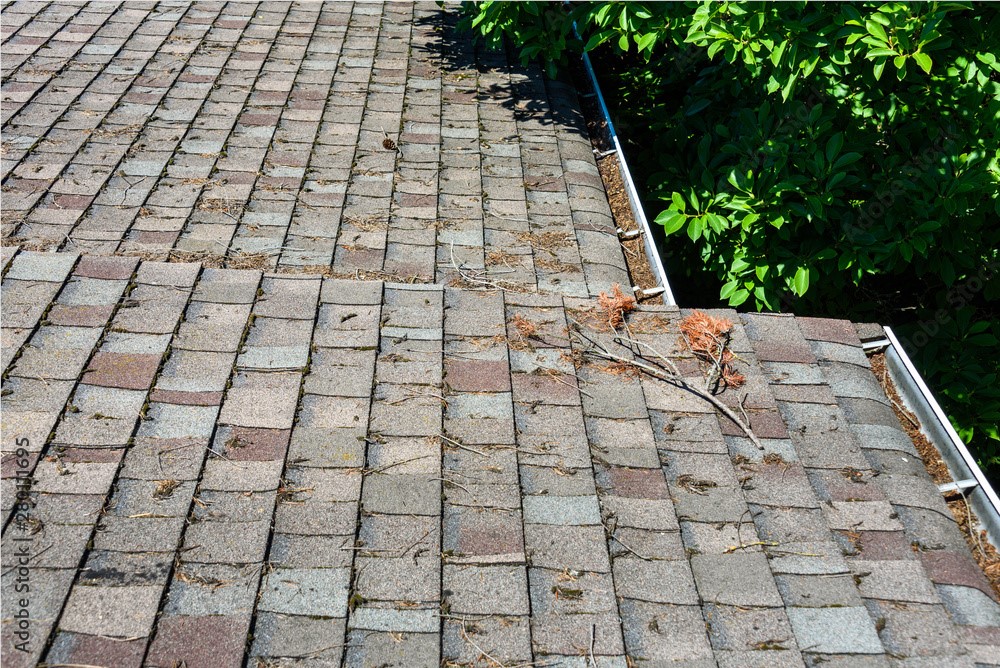Your Residential Roof (It’s Not Just Shingles)

Residential roofs contain many different components. Your roof shingles are the most visually stimulating part of your roof. Other parts help your home breathe, carry water away, and help keep your home dry and safe.
What are Roof Shingles? What Purpose Do They Serve?
Shingles are an inexpensive roof covering. The composition of a shingle includes a base mat, asphalt on both sides of the shingle, and granules on top. Ground stone and minerals comprise the granules. There are several reasons that shingles have granules on them.
- The granules help with installation by providing a surface for roofers to walk on. Additionally, the granules prevent shingles from sticking together.
- The inclusion of granules improves the durability of the shingle.
- The granules help prevent your shingles from ultraviolet rays.
- Granules can come in many colors and provide an aesthetic quality to your roof.
What is a Starter Strip on a Residential Roof?
A starter strip is installed where your shingles start. The strip is adhered to your roof to prevent driving rain from getting under your shingles. By adhering the starter strip down prevents the shingle from blowing off. Additionally, the starter strip creates a straight line for each new row of shingles.
Leak Barrier also know as Ice and Water Shield Helps Keep You Safe and Dry
A leak barrier provides an extra layer of security on tricky points of your residential roof that are more susceptible to leaking. Leak barriers help prevent ice dams from forming. It self-adheres to these vulnerable parts of your roof deck to provide an added layer of protection.
Why You Need Roofing underlayment
The underlayment lays between the shingles and the decking and is completely hidden. It helps protect your residential roof deck from water damage. It comes in several different materials; asphalt-saturated felt, rubberized asphalt, or non-bitumen synthetic underlayment.
How Important is Drip Edge on my Residential Roof?
A drip edge is a thin piece of angled metal or flashing that helps direct water away from your fascia. Without a drip edge on your roof, water can get behind your gutters and eventually rot your fascia and decking. Drip edge is not the most exciting piece of roofing material, but it works very well in directing water to the gutters.
What is Roof Decking?
Decking is made from plywood and serves as the foundation for your roof. That said, any issue with your decking will lead to replacing the plywood. Typically, if your decking has started to rot or has significant moisture damage, those are grounds to replace it. Roofers will assess damage to your decking during a complete roof tear-off. Dependent on the level of damage, it may require getting all of it replaced.
Why is Roof Flashing so Important
Flashing is a metal strip used to direct water away from areas of your residential roof.

Imagine a lack of flashing on this chimney. Heavy rain would allow water to drip between the shingles and chimney.
The Valley of Your Roof is Prone to Leaking
A valley on your roof is where two slopes meet. Since the valley is a convergence of roof slopes, there may be considerable water flow during a rainstorm. These areas can leak if there is improper flashing installation. All of your roof valleys should have an ice shield installed for an added layer of protection.
Residential Roof Venting
In most homes, air should flow in and out of your home. Why? To reduce heat and condensation collection in your attic. Without airflow, excess condensation can lead to mold, rot, and preliminary replacement of your roofing system.
Vent Pipe for Natural Gas and Plumbing
Dependent on the features of your home, you will find numerous vent pipes on your roof. Do you have a natural gas furnace, oven, or fireplace? If so, you will find natural gas venting. You will find a plumbing vent pipe that lets sewer gasses escape. While important, these don’t have to do with the proper air ventilation of your home.
Vents Let Your Home Breathe
There are several types of vents for your home. What you have may depend on the type of roof you have.
- Ridge Vent
You will find ridge vents at the very peak of your roof. They typically run the length of the ridge of your roofline. Ridge vents partner with the soffit and allow air to flow in and out of your home. The vents are beneficial for ventilation and help reduce HVAC bills.
- Ridge Caps
The ridge cap is a specialized layer of shingles that protects your ridge vent. They are typically thicker than a regular shingle and come pre-bent. Their additional thickness helps protect them from harsh wind damage.
- Turtle vents, gable vents, turbine vents, and more
There are several other types of vents that tie into your roofing system.
- Turtle vents are easy add-ons to tie into your roofing system. Typically, these are added if you do not have adequate ventilation.
- You will find gable vents on the ends of the gable roof. The vents allow air to enter one side and out the other. The gable vents may be paired with a soffit system to move air in and out.
- Wind power causes the turbine to spin and pull air out of the attic.
Where are the Eaves on my Home?
Step outside your home and lookup. You will likely be standing under the eaves. The eaves of your home hold your soffits. Your gutters are attached to the fascia, which makes up the far end of the eaves.
Fascia and Soffits are the Backbones of Your Roof
Soffits are the bottom of your eaves. If you walk directly outside your home and look up, you will likely see your eaves. The fascia connects at a 90-degree angle to make the fascia. Fascia acts are the support for the gutters and starter shingle.
Gutter Systems Keep Water Moving
Your gutter system moves water away from your home when it rains or snow melts. Keeping water away from your home and foundation is imperative to keeping your home dry and mold-free. Gutters are the key to accomplishing this.
What Does a Gutter do?
Gutters are open-top metal channel that helps move water from your roof and ultimately away from your home via the downspouts. Gutters need to cleaning at least once a year to ensure that water is not backing up. We recommend cleaning them in the spring and the fall. However, you may need to clean your gutters more often if your home is surrounded by trees.
What is the Purpose of a Downspout?
Downspouts attach to your gutter system and direct water down and away from the foundation of your home. Your downspouts can spill out onto the ground, and others connect underground to keep your foundation dry. Keeping excess water away will prevent damage to your foundation and even leaks in your basement. Kearns Brothers have installed residential roofs for nearly 40 years in the metro Detroit area. roofline Brothers have accrued numerous best-in-service awards for installing residential roofs. Reach out today to schedule a complimentary roof consultation with our team of experts.
Tags
Subscribe to Kearns Brothers's Blog



Comments